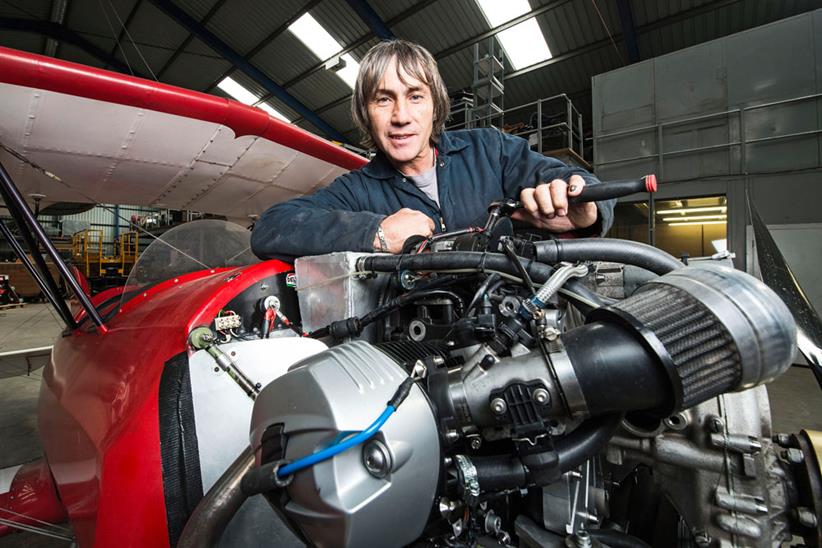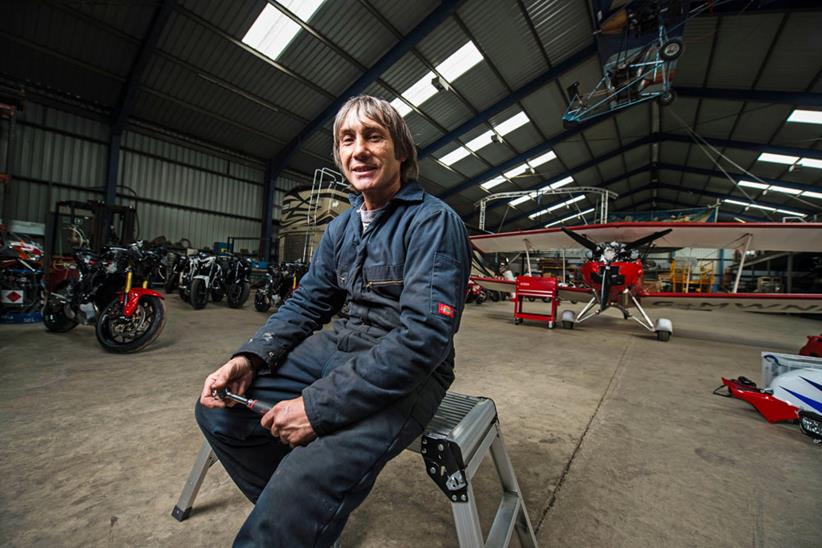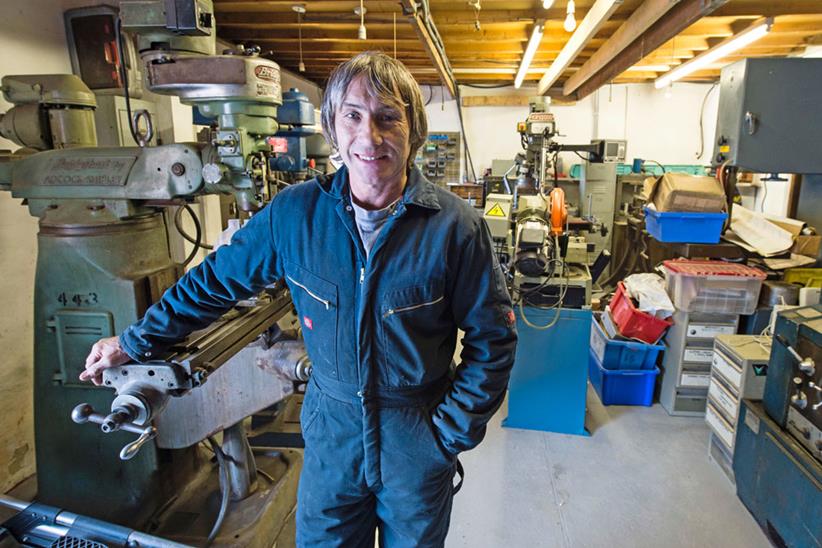Ron Haslam’s hangar full of bikes (and a plane)
When you’ve won TTs, raced GPs and spent a lifetime fettling, a shed just isn’t big enough. You need a Haslam Hangar…
![]() otorcycle racers have a long history of growing old disgracefully. The likes of Barry Sheene smoked, drank and womanised, seemingly never growing out of the hellraising antics they enjoyed in their prime.
otorcycle racers have a long history of growing old disgracefully. The likes of Barry Sheene smoked, drank and womanised, seemingly never growing out of the hellraising antics they enjoyed in their prime.
Ron Haslam’s illustrious TT, GP and production race career spanned the good old days, but instead of following his former peers into retirement he remains a Peter Pan figure of the paddock: a man who simply refuses to grow up.
Part of that is down to having a 32 year-old World Superbike race winner as a son. Leon Haslam is a man who, just like his dad, spends the vast majority of his time messing around on motorbikes. For the Haslams, bikes aren’t just a tool to keep sharp. They’re a way of life, a passion so ingrained it defines them as human beings.
Twenty times a year you’ll find Ron at Donington Park, leading by example at the famous Ron Haslam race school. In between showing incredible patience and proven teaching skills to his pupils (who range from nervous track virgins to wannabe world champions), the 59 year-old lights up the rear Bridgestone of his Fireblade on the exit of Coppice or spectacularly backs it in to Redgate – more often than not with a terrified pillion on the back.
Rather more seriously, he’s ridden on track with Leon, WSB champ Jonathan Rea, and Alex and Sam Lowes. While they are marginally faster than Ron, none of them can outbrake him into the Melbourne Loop. Yes, he’s still that good.
Away from the track, Ron is a busy man. In fact, he never stops. The famous Haslam clan continues to grow, with his three offspring – Leon and his two sisters Emma and Zoe – all living independently, but on site, at the Haslam farm. With that comes four grandchildren all vying for attention. You can only imagine how cool they think their Grandad is, so it’s fair to say he’s in demand.
![]() But when he’s not engrossed in entertaining toddlers or trying to beat Leon on a trials bike, Ron’s big passion is flying.
But when he’s not engrossed in entertaining toddlers or trying to beat Leon on a trials bike, Ron’s big passion is flying.
His pride and joy is a Renegade biplane, but Ron’s love of the aeronautical world isn’t just the flying itself; it’s the constant engineering involved in making his plane the best it can be. Throughout his racing career Ron was called upon time and time again for his superb development skills and feedback – skills that he now mixes with true engineering prowess.
“It had a two-stroke motor in it when I got it, which was crap. It only just had enough power to take off, so I put a 1200 BMW boxer engine in it and it’s fantastic.
“I physically put that in myself. I used the GS motor because it fitted nicely, but I did have to do a few things to it. I had to make plates up and I put in a three-to-one gearbox. So now it goes from the crankshaft through the gearbox, and then there is a cush drive. I used the BMW ignition and took it up for a test flight. Because it was the first flight I’d kept all the wires long, but when I got down and was happy with it I started making them all the right length.
“It was all going to plan until I cut the last wire. As I cut it, it dropped down and of all places landed on the battery terminal. I thought I saw a tiny spark, but I wasn’t sure. It turned out I was right and it blew the ignition box. I tried to get a new one but you had to buy the ignition box, the key and all the other stuff that went with it. They wanted £3500! I wasn’t prepared to pay that so I decided to put a Motec ignition system on it, which cost me £2000. Then I had to wire it all for the Motec and that took me two weeks.
![]() “I had a lot of people saying that it couldn’t be done and when I finished it wouldn’t fire up or do anything. The Motec system has got a fault finder – it’s essentially numbers in boxes up to 100. I ended up having to change them one by one up to 100 until each fault disappeared.”
“I had a lot of people saying that it couldn’t be done and when I finished it wouldn’t fire up or do anything. The Motec system has got a fault finder – it’s essentially numbers in boxes up to 100. I ended up having to change them one by one up to 100 until each fault disappeared.”
With the engine running well enough to take off and fly, it was time to fine tune the fuelling – and what better way to do it than by himself making the adjustments as he flew? “I went up with a little laptop computer so that I could adjust it while I was flying along. The trouble is that if you hit the wrong button it will stop the motor dead! Over the years I’ve had to make some interesting landings and then ring home for some help.
“Getting it back isn’t easy. You can actually break the plane down and transport it that way, but the last time I landed in the neighbour’s field and it only took four of us to lift it over a few fences.”
To anyone who has a rational fear of flying (never mind an irrational one), the thought of fabricating your own parts and fitting a motorcycle engine into an old biplane is simply terrifying. But for Ron it’s all in a day’s work – even if that day includes an emergency landing or two.
But really, this lack of fear isn’t surprising. Ron is a TT winner after all, and they’re hardly famed for their timorous ways. However, there was considerable hard work involved in winning at the Isle of Man: “It took me three years to learn the course,” he says. “The first year I went I didn’t know where I was going, I didn’t know anything. The second year I started to get to know it, but there were still doubts. By the third year I knew everything I needed to know. I used to spend a couple of weeks in winter over there going round and round, just to get to know all the details: ‘Yes, this is a kink, but it’s flat out’. I’d spend all day going around on a bike and then at night I’d go round in a car.
![]() “I learned it differently from other people. Most learn it by names and sections. I just set off and treated it as one big track, the whole thing as a lap. I got to know every little dip, bump, kerb, everything. I couldn’t tell you the name of the corner but I could tell you everything else about it, just like I can on a short circuit.
“I learned it differently from other people. Most learn it by names and sections. I just set off and treated it as one big track, the whole thing as a lap. I got to know every little dip, bump, kerb, everything. I couldn’t tell you the name of the corner but I could tell you everything else about it, just like I can on a short circuit.
“It was hard to do all my learning because it wasn’t during a race, so you weren’t at race speed. But saying that, the Mountain section was ok because there wasn’t much traffic and not many side roads, so I just used to go flat stick. At night you could see headlights, so that meant you could use all the road! I also learned a lot from the scenery, as you could tell a lot from that as to where each part of the track went.
“I ended up going back a few years ago for Honda to do the parade lap, along with a pillion lap of a competition winner, but the track was so different. They’ve shifted so many of the trees and bits I remembered that there were parts where I didn’t have a clue where I was going.
“Honda gave me a brand new Fireblade with zero miles on the clock. Brand new tyres, brand new everything. The winner was this young girl. She lived on the Isle of Man and had been a sidecar passenger. I managed to set off ahead of the actual parade lap, which meant I got a clear run.
“I headed off down Bray Hill which was dead easy, and then over the rises. There are three of these; the first two are flat out, but the third one has a kink in it so you have to shut off and come back one. I hit the first rise flat out no problem, and did the same on the second – but with it being a stock production bike it wheelied, and when it landed it went lock-to-lock and I ended up going kerb-to-kerb across the road. I managed to calm it down but you know when it’s close” Well it was close!
“I won the TT in 1981 and 1982. They took it off me in ’81 [after Graeme Crosby had a time penalty cancelled], but in ’82 my fastest lap was 114mph. On that day with the pillion, on a standard road bike with brand new tyres from a standing start, I did 110mph [Ed: Good grief. This has to be the fastest TT pillion lap ever. If you are the girl Ron mentioned, and you have regained the ability to speak, please get in touch.]
![]() Thanks to flying, Ron’s non-motorcycle life is almost as hair-raising. “The last problem I had with the plane was when I was running in a crank. It was getting late, a bit dark and a bit misty. I was only taking it steady, but the plug lead jumped off. I was only about four miles from home, but it went onto one cylinder and it won’t fly on one cylinder! It was popping away so it was a case of ‘pick a field’. I ended up putting it down in one with a load of cows in. What I didn’t realise was I’d just gone over the police headquarters where the helicopter was. He must have heard me, and got in his helicopter to follow me to see if I’d crashed. He landed beside me and I explained I’d had to force land it. He was like, ‘All right then, but if you can’t get it going come over and have a cup of tea.’ And then he flew off.
Thanks to flying, Ron’s non-motorcycle life is almost as hair-raising. “The last problem I had with the plane was when I was running in a crank. It was getting late, a bit dark and a bit misty. I was only taking it steady, but the plug lead jumped off. I was only about four miles from home, but it went onto one cylinder and it won’t fly on one cylinder! It was popping away so it was a case of ‘pick a field’. I ended up putting it down in one with a load of cows in. What I didn’t realise was I’d just gone over the police headquarters where the helicopter was. He must have heard me, and got in his helicopter to follow me to see if I’d crashed. He landed beside me and I explained I’d had to force land it. He was like, ‘All right then, but if you can’t get it going come over and have a cup of tea.’ And then he flew off.
“I got my torch out and saw that the plug cap had come off so I put it back on and got going. The trouble was it was dark, and I didn’t have a clue how to get back to the farm. It took a while, but I eventually found a clock tower I knew, and pieced together what roads I could see and managed to land it in the dark at the farm.”
Ron’s plane is now well sorted, but thanks to his constant quest to challenge himself, you know that the next scrape is just around the corner. And that’s just the way he likes it.
Words Michael Guy Photos Gareth Harford, Bauer Archive








